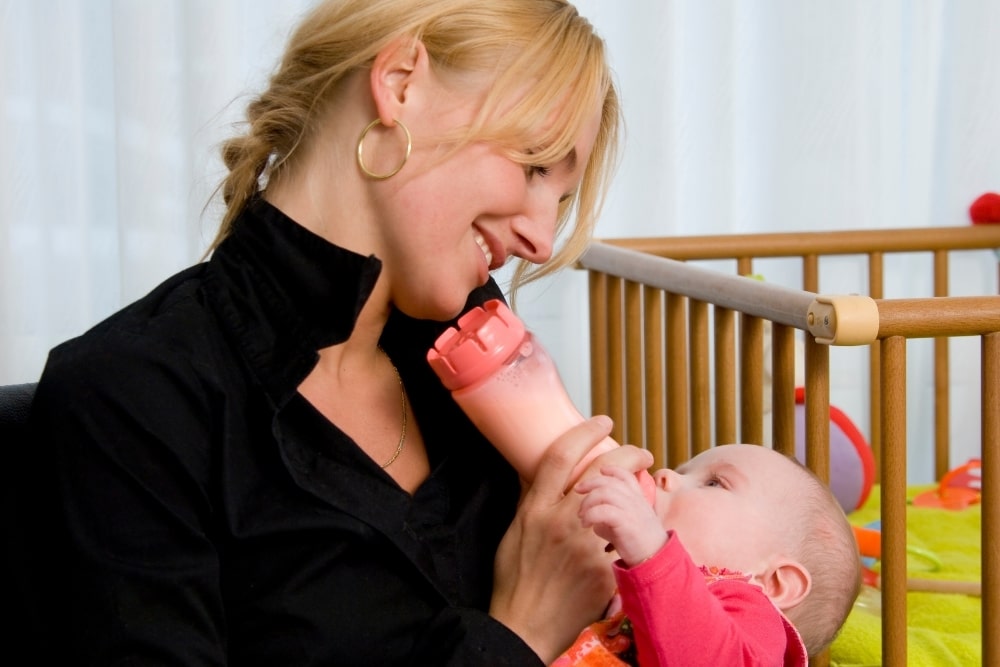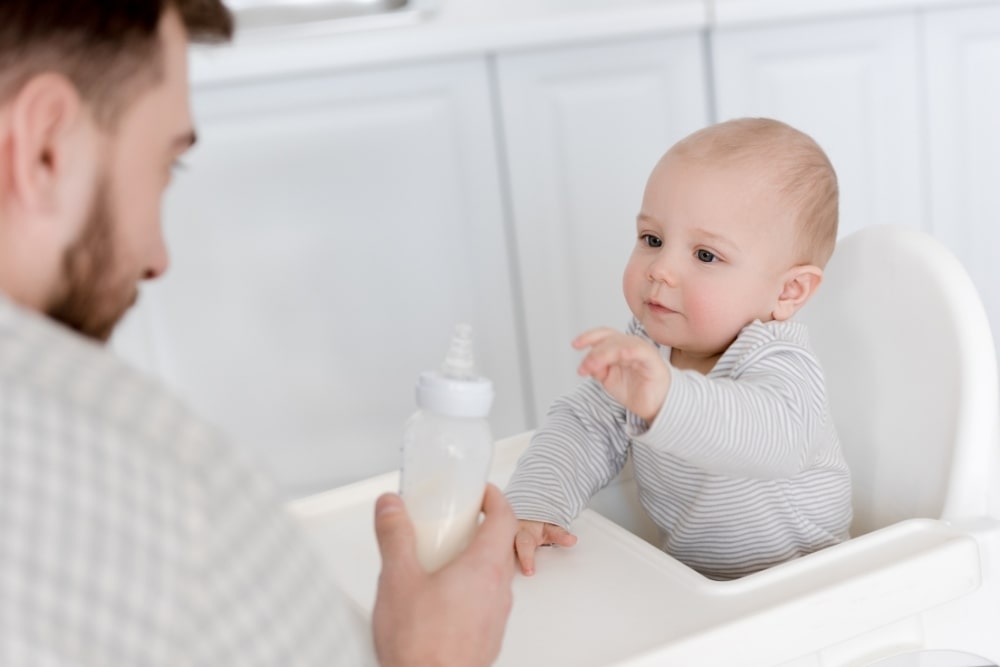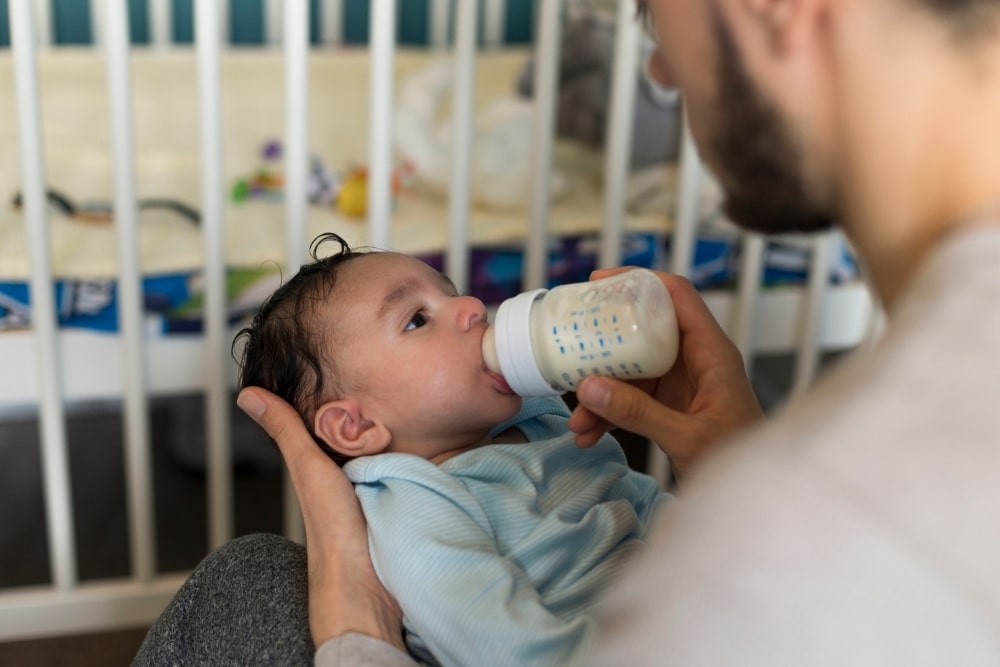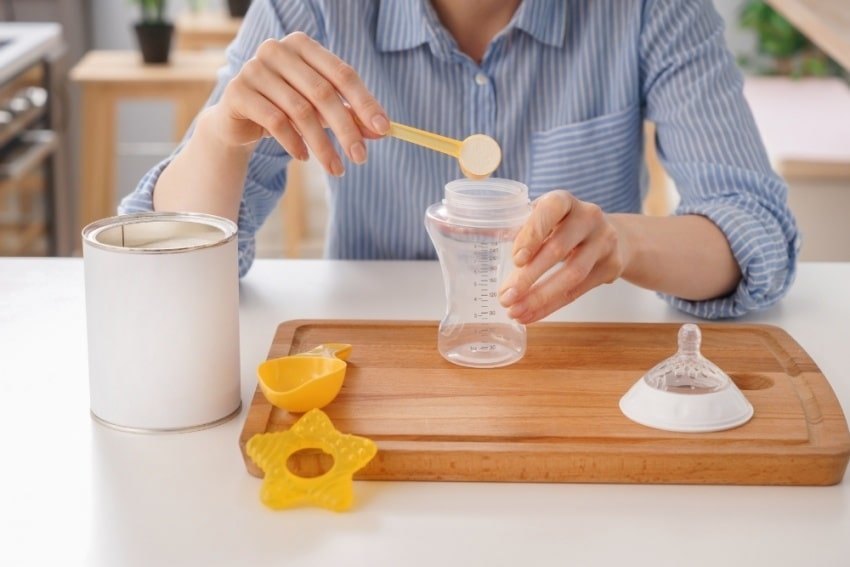Breastfeeding can be an incredibly rewarding journey. It allows you time to create a very special bond with your baby while providing them with the best possible nutrition.
But it can also be extremely demanding on a mom and not every mom who plans to breastfeed can.
Some moms who may be looking at alternatives to exclusively breastfeeding may consider supplementing with formula. Their breastfeeding journey may not be going to plan and they may be looking to transition their baby to formula.
Whether you are ready to start transitioning your baby to formula or you need to make a complete switch. We have put together a wealth of information and techniques to help the transition be as smooth as possible.
Reasons Why You Would Move From Breastmilk To Formula
There are many reasons why moms introduce bottle feeding and formula to their breastfed baby.
The reasons may be medical or simply for convenience. Some reasons why moms may switch to baby formula are:
- Low milk supply.
- Planning to stop breastfeeding by a particular age – usually age 1.
- Self-weaning before age 1.
- The inability to pump enough milk to satisfy babies when mom is away from them.
- The baby is unable to nurse effectively or has latching problems.
Another common reason moms may decide to transition to baby formula is that when baby’s teeth come in, some moms experience a great deal of nipple biting.
Steps For Easy Transitioning
There are 3 main ways in which you can introduce your baby to formula. Remember that each baby is different and what works for one may not necessarily work for another. Use whichever method works for your baby and you.
View in gallery
Partial Weaning
Partial weaning is when you plan to continue breastfeeding but will supplement some feeds with formula. This could mean substituting just one feed a day with formula.
For this method to be as successful as possible you need to be prepared that you will have to try a few different formulas with your baby until you find the one that suits them best.
Once you have found one they like and are happy to take then you can simply start substituting one feed with formula instead of breastmilk.
This method is often used by moms who are returning to work but still wish to continue breastfeeding when they are with baby.
Gradual Weaning
Gradual weaning is a great method if you are planning on stopping breastfeeding completely in the near future. It works by gradually giving your baby a little less breastmilk each day until they are drinking formula 100% of the time.
Another way of doing gradual weaning is to combine both breastmilk and formula in one bottle. Then gradually reduce the amount of breastmilk in the bottle. Ensure that you continue to follow the correct mixing instructions.
Switching Cold Turkey
It is not generally advised that you make a cold turkey switch from breastmilk to formula. But there are certain circumstances where you may not have another option.
If your baby is already used to drinking breastmilk from a bottle the move will be more than likely be a little easier on them. However, if your baby has only ever had milk from the breast, you may well run into some issues such as refusing the bottle.
This is completely understandable and is a huge change, a different experience, nipples are different, the formula is not the same as breastmilk – be patient.
Taking Care Of Mom While Weaning
When you start to transition your baby from breastmilk to formula, especially if you go cold turkey, there is a chance that you will experience breast engorgement. This can be painful and uncomfortable.
If you are suffering you can check out our article on How To Get Rid Of Engorged Breast While Not Breastfeeding for some helpful advice.
View in gallery
Guide To Switching From Breastmilk To Formula
If you are considering making the switch here are a few steps to help the transition be as easy as possible.
Discuss With Your Pediatrician
Before you make any changes it is advised to discuss your plans with your pediatrician. They can offer you advice with regard to the best formula to try, bottles and nipples that may also be a good choice.
Start By Offering Expressed Breast Milk In A Bottle
The first and often most difficult step in transitioning to formula is getting your baby to take a bottle that isn’t attached to their mom’s. After all, they are used to being close to their moms for every feed.
To start the process, begin by putting breast milk in a bottle and getting them to successfully take that. Once they get used to drinking from a bottle the move to formula should be a little easier.
You will need to find the right bottle for them and there are some great bottles available that are designed to replicate the feel of a real nipple and breast. Check out our review of the Mimijumi vs Comotomo bottles which do just this.
Gradually Introduce Formula
Take it slowly, to begin with, this will give your baby the chance to get used to the formula. It will also give their digestive system the chance to adapt to the change in feeding.
Get Them Interested In The Bottle
Now, this can be a tricky one, trying to get a baby who is used to only getting milk from their mom to take any interest in a bottle, especially when babies can smell the breast milk from their moms.
You need to try and get their minds off the mom and this can be done by telling a story, singing a song they love, anything to distract them. The trick then is to redirect their attention to the bottle.
View in gallery
Drop A Feeding Session
By taking things one step at a time it is more likely that the transition will be smooth. Drop one breastfeeding session and substitute with formula.
Gradually reducing your breastfeeding sessions over time until they are completely weaned. This will also help to prevent engorgement.
Formula In The Day And Breast At Night
No matter how successful your transition goes some babies will just refuse to take a bottle at night, preferring to breastfeed.
If you find your little one is like this, you could try feeding formula in the daytime and then nursing at night only. You could maintain this schedule until they are completely weaned off breastmilk.
Offer Formula When Baby Is Hungry
When babies are hungry they are more likely to take anything you offer them. But be very aware that there is a fine line between ‘hungry’ and ‘hangry.’
Once your baby is hangry they are unlikely to take to anything new.
Get Someone Else To Feed Them
Babies become so used to only being fed by their moms that it can be difficult to break the association.
To change this association your baby needs someone else to feed them. Your partner, grandparent, or even a friend can feed them with a bottle. This will also help your baby to not get distracted by the smell of your breast milk.
Mix Breast Milk And Formula
If you have tried a few different formulas and your baby is still just not taking to it well, you could always try mixing your expressed milk with the formula.
This will create a smell and taste that your baby recognizes, which can help the transition to go a little smoother.
As your baby becomes accustomed to feeding on a bottle you can gradually reduce the ratio of expressed milk to formula as shown below.
- Day 1 & 2: 25% formula and 75% expressed breast milk.
- Day 3 & 4: 50% formula and 50% expressed breast milk.
- Day 5 & 6: 75% formula and 25% expressed breast milk.
- Day 7: 100% formula.
You can always adjust this schedule to suit your baby, increasing the days or changing the ratio of breast milk to formula.
View in gallery
Mistakes To Avoid While Transitioning
All moms eventually stop breastfeeding and many often struggle to start. So if you are considering transitioning your baby to formula here are a few mistakes that you can avoid along the way.
Supplementing Too Early
Many moms choose to supplement their breastmilk with an infant formula but this is often done far too early.
This is often an easy trap to fall into especially if mom is heading back to work and wishes to continue breastfeeding when she is with her baby but offer an infant formula when the baby is at daycare.
There are two issues that arise due to supplementing too early.
- Supplementing too early can cause mom’s milk production to drop or never even get going properly.
- Switching back and forth too soon between the bottle and breast can cause nipple confusion for the baby, which may make them reject the breast altogether.
Ideally, you should wait until your baby is 3-4 weeks old. This gives your body ample time for your milk supply to regulate.
If your baby is heading to daycare at 6 weeks old then those 2-3 weeks will give you plenty of time for the baby to get used to a bottle.
Transitioning Too Quickly
This is a common mistake that moms make is transitioning too quickly.
Quick transitions do not allow your baby the time they need to learn to drink from a bottle. While slow transitions will also help to prevent engorgement and discomfort for mom.
If you are looking to fully switch from breastfeeding to formula feeding, you should expect it to take around a month in order for your baby to fully weaned and drinking formula full time.
Dropping Too Many Nursing Sessions At Once
For this transition to work well it has to be a gradual process. Another of the most common mistakes is dropping too many feeding sessions at once. But it can also be difficult to decide which ones to drop.
One way is to choose a feeding session that is the most inconvenient for you. So if you hate that midnight feed then why not get Dad to give your baby a bottle.
View in gallery
Not Getting Your Partner Involved
If you are a breastfeeding mom you know that the responsibility obviously falls on you. However, when you are transitioning to formula, not getting your partner involved is a huge mistake.
Dads can get some great bonding time with their little ones if they can share some of the feeding responsibilities.
It will also make the process much easier as babies are more likely to accept their first bottle from dad. If dad isn’t around, friends and relatives are just as good a choice.
The logic here is that if your baby is hungry and you try to feed them a bottle, they will probably just scream and cry until your feed them as they think that is the only place food comes from.
But when someone else brings the bottle, your baby won’t be distracted by the smell and presence of you.
Not Trying Different Bottles/Nipples/Teats
Getting a breastfed baby to take to a bottle is never going to be guaranteed. You will get some babies that will eat from whatever is put in their mouths, and others are so picky you may never be able to transition them.
If you find yourself in the position where your baby is rejecting the bottle you could try switching nipples or bottles. I know it is a pain to keep changing bottles or teats and it can be quite expensive but once you find the perfect one it is well worth it.
A little piece of advice: don’t buy any bundles of bottles until you are sure that your baby is happy with it.
Being Adamant That One Type Of Formula Is Right
One of the biggest factors in transitioning your baby to formula is of course the formula. If your baby isn’t adjusting well to a formula it is well worth considering switching.
Your baby may be spitting up more than they did, they may have allergies – but there is no need to panic as your pediatrician can help you to navigate the minefield of baby formulas available and help you find the perfect one for your little one.
Keeping Mixed Formula Out For Too Long
When a mom is breastfeeding her baby and they have a diaper blowout in the middle of a feed, mom just stops feeding and sorts them out.
View in gallery
Breastfeeding does mean that milk is always ready at the perfect temperature, it never goes stale and you never need to worry about it being kept out of the fridge for too long (unless it is expressed).
So when a mom starts feeding their baby formula, it’s welcome to a world of clock watching to ensure that the bottle is still fresh enough to drink.
Feeding old formula can cause your baby to become sick. And ‘old’ doesn’t mean it’s been sat around for 3 days. It means any bottle of mixed formula that has been sat around at room temperature for more than an hour.
Always ensure any unused formula is thrown away or formula that has been sitting around for too long.
Not Getting The Temperature Right
Breastfeeding mothers rarely think about having to heat up a bottle. Their breastmilk comes out of the source at the perfect temperature each and every time. But formula is not created that way.
If this is your first time heating up baby formula then there is a strong possibility that you may make a few errors along the way.
Formula or breastmilk should never be heated in the microwave as it can cause hot spots in the milk that can burn your baby. The formula should never feel warm or hot it should be lukewarm – this is the perfect temperature for your baby.
Giving Too Much Or Too Little Formula
Both of these mistakes are very common. It may be that you think I’ll just give them a little taste so that they can get used to it.
But then they are still hungry and you know where they are going to turn in order to satisfy that hunger – yes you guessed it – breastfeeding.
This can become a vicious circle especially if you are trying to fully transition to formula. The bottle of formula that you give them needs to fill them up and satisfy their hunger. If it doesn’t then they are never going to fully transition.
View in gallery
In the same respect, feeding your baby too much formula is just as bad.
If your baby is eating too much formula, they will still be full when it comes time for them to nurse which means mom is on her way to painful engorgement.
It is quite easy for a baby to overeat especially when it flows from a bottle much easier than a breast. Overeating can also cause excessive gas, spit-up, and too much weight gain.
Remember the idea is that one bottle should replace one nursing session. So as a general rule, this will roughly be 1-3 oz for newborns, 4-6 oz for 2-4 months and 6-8 oz for 6 months plus.
Waiting Until Baby Cries For Food
HANGRY!! The word may not be in the dictionary but it is a very real feeling and babies are no different. When a small baby is hungry they will give you ques such as stirring and being a little fussy.
Once they start crying, they are way past hungry and are not hangry!
The hangry stage is not the time to try to introduce a bottle for the first time. It will end in disaster as they are so worked up that they will not be patient enough to try anything new.
If they are at this stage you could try letting them nurse from each breast in the hopes that it will calm them down and bring them back to just hungry. Then you could try a bottle. They are far more likely to accept change when they are calm.
Which Formula Should I Use?
There is no magic formula that will suit every baby. Each baby is different and will also have their own unique feeding requirements and preferences. But we have found a few that can offer a great starting point.
The best choice that you can make is a formula that mimics breastmilk with regard to nutrients, flavor, and texture. These are our two favorites:
Enfamil Enspire Infant Formula
Enfamil Enspire was created with breastfed babies in mind. It is non-GMO and also contains MFGM and Lactoferrin which are both found in breastmilk.
This makes this formula the closest to breastmilk. MFGM is a fat-protein that supports brain development, while Lactoferrin is an immune-building nutrient.
Many parents have reported that their breastfed babies have taken this formula with little resistance.
[amalinkspro type=”cta-btn-css” ctabtn-id=”” asin=”” apilink=”https://www.amazon.com/dp/B01ASIEJPA?tag=mominformedcom-20&linkCode=osi&th=1&psc=1″ addtocart=”false” new-window=”true” nofollow=”true” alignment=”aligncenter”]Check Price[/amalinkspro]
Similac Pro-Advance Non-GMO Infant Formula with Iron
This is Similacs closest option to breastmilk. It contains their unique blend of DHA, lutein, and vitamin E all of which are critical for brain and eye development.
As well as Human Milk Oligosaccharide (HMO) an immune nourishing prebiotic naturally found in breast milk.
[amalinkspro type=”cta-btn-css” ctabtn-id=”” asin=”” apilink=”https://www.amazon.com/dp/B075ZXXM84?tag=mominformedcom-20&linkCode=osi&th=1&psc=1″ addtocart=”false” new-window=”true” nofollow=”true” alignment=”aligncenter”]Check Price[/amalinkspro]
FAQs
How long does it take for a baby to get used to formula after breastfeeding?
It is important that you factor in a transition period of around two weeks. This allows your baby’s digestive system to adjust. This would be the same as if you were just moving up a stage in your regular formula.
Can you switch from breastmilk to formula cold turkey?
it is not recommended that you make a cold turkey switch from breastmilk to formula. However, there are certain circumstances where you may need to stop breastfeeding immediately.
Do babies get constipated when switching from breastmilk to formula?
It is common for a breastfed baby to experience constipation for the first time if they are switched from breastmilk to formula.
It is simply because their little bodies are not used to digesting anything other than breastmilk. Ensure that you introduce formula gradually in order to try to avoid constipation.
What formula is closest to breastmilk?
Enfamil Enspire is our closest formula to breastmilk. It is the first and only formula to include MFGM and Lactoferrin, two key components that are also found in breastmilk that help to support your baby’s mental development and immune system.
The Final Thought
Introducing formula to your baby, whether it be to supplement your breast milk or to transition them completely to formula, requires patience and consistency.
You need to understand that these are enormous changes for your little one and they need time to adapt, a successful transition cannot happen suddenly.
Hopefully, all the information that we have shared with you will help to make your transition a smooth and successful one.






![15 Formulas Closest To Breastmilk in [year]](https://cdn.mominformed.com/wp-content/uploads/2021/08/baby-drinking-milk-bottle-feed-150x150.jpg)

